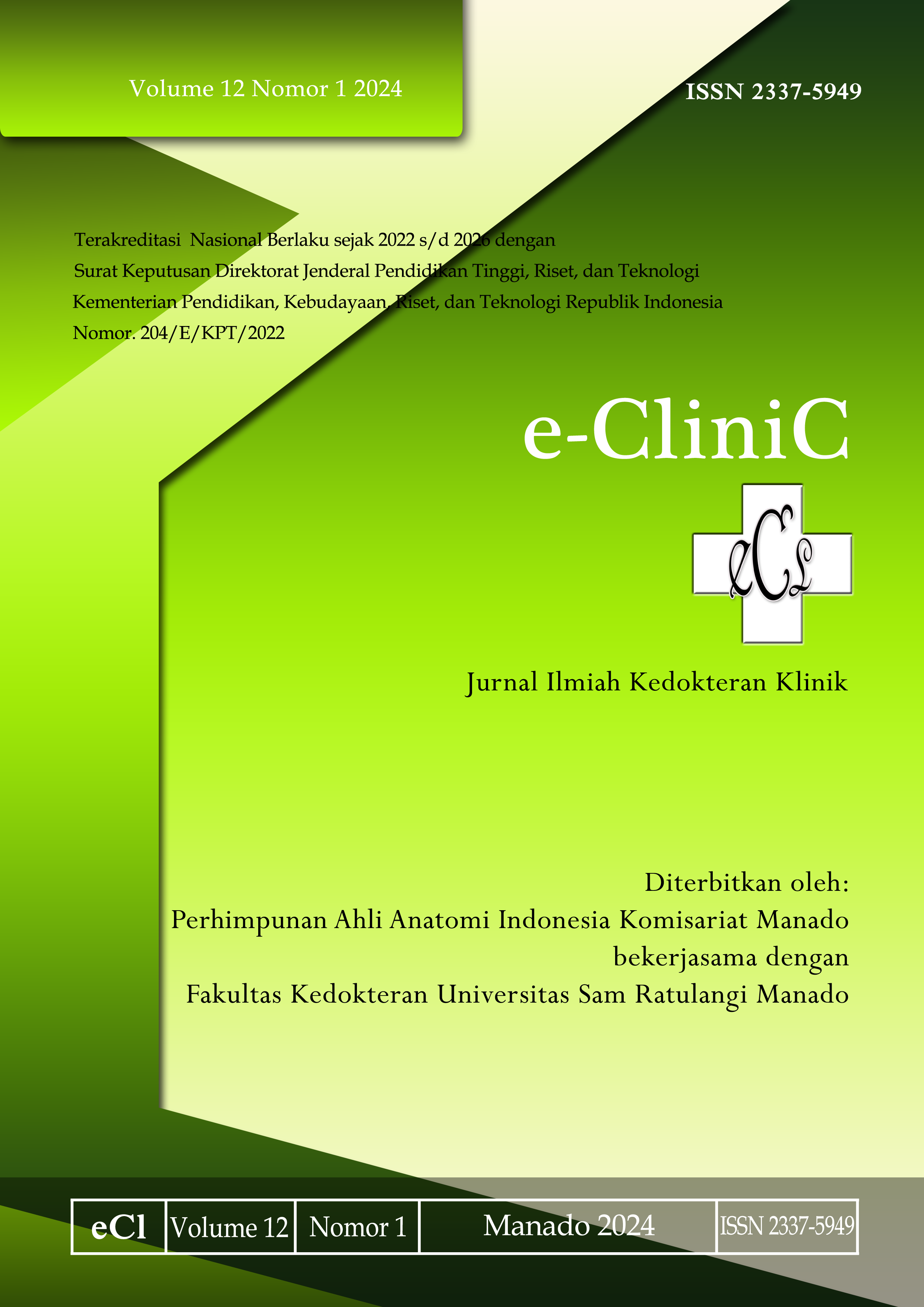Karakteristik Pasien Operasi Rekonstruksi Hipospadia yang Menjalani Terapi Oksigen Hiperbarik di RSUP Prof. Dr. R. D. Kandou dan RS Siloam Manado
DOI:
https://doi.org/10.35790/ecl.v12i1.46457Abstract
Abstract: Hypospadias is a congenital abnormality of urethral meatus in male. Hypospadias can be corrected by urethroplasty. Hyperbaric oxygen therapy (HBOT) can accelerate wound healing after surgery by increasing oxygenation, angiogenesis, and collagen synthesis. This study aimed to describe the characteristics of hypospadias reconstructive surgery patients who underwent hyperbaric oxygen therapy. This was a quantitative and descriptive study. Data were analyzed with SPSS ver 22.0. The results showed that from 20 patients who underwent reconstructive hypospadias surgery, 10 patients received HBOT as adjuvant therapy and 10 patients received conservative therapy post-surgery. The mean age of patients who underwent HBOT was 17.4±7.1 years old. The most frequent type of hypospadias found was subcoronal (35%), followed by the other types: glandular (20%), distal penile (10%), midshaft penile (10%), proximal penile (10%), penoscrotal (10%), and the least was scrotal (5%). All of the patients underwent urethroplasty with Sidik-Chaula and Manset Flap method. In conclusion, the mean age of patients who underwent HBOT was 17.4±7.1 years old, and the most frequent type of hypospadias found was subcoronal.
Keywords: hypospadias; hyperbaric oxygen therapy; characteristics of hypospadias patients
Abstrak: Hipospadia merupakan kelainan kongenital meatus uretra pada laki-laki. Hipospadia dapat dikoreksi dengan uretroplasti. Terapi oksigen hiperbarik (TOHB) dapat mempercepat penyembuhan luka pascaoperasi melalui peningkatan oksigenasi, angiogenesis, dan sintesis kolagen. Penelitian ini bertujuan untuk mengetahui karakteristik pasien rekonstruksi hipospadia yang menjalani TOHB. Jenis penelitian ialah deskriptif kuantitatif dengan alat analisis SPSS ver. 22.0. Hasil penelitian mendapatkan 20 pasien yang dilakukan operasi rekonstruksi hipospadia; 10 pasien menjalani TOHB dan 10 pasien menjalani terapi konservatif pasca pembedahan. Rerata usia pasien yang menjalani TOHB yaitu 17,4±7,1 tahun. Tipe hipospadia yang paling sering ialah subcoronal (35%), diikuti tipe glandular (20%), dan sisanya ialah tipe distal penile (10%), midshaft penile (10%), proximal penile (10%), penoscrotal (10%), dan yang paling sedikit ialah tipe scrotal (5%). Semua pasien menjalani operasi dengan metode Sidik-Chaula dan Manset Flap. Simpulan penelitian ini ialah rerata usia pasien yang menjalani TOHB ialah 17,4±7,1 tahun dengan tipe hipospadia yang paling sering ialah subcoronal.
Kata kunci: hipospadia; terapi oksigen hiperbarik; karakteristik pasien hipospadia
References
Turkyilmaz Z, Karabulut R, Atan A, Sonmez K. Redo Hypospadias repair: comparison of three different methods. Urol Int. 2020;104(5-6):391-395. Doi: 10.1159/000504947.
Khan M, Majeed A, Hayat W, Ullah H, Naz S, Shah SA, et al. Hypospadias repair: a single centre experience. Plast Surg Int. 2014;2014:453039. Doi: 10.1155/2014/453039.
Snodgrass W, Bush N. Staged tubularized autograft repair for primary proximal hypospadias with 30-degree or greater ventral curvature. J Urol. 2017;198(3):680-6. Doi: 10.1016/j.juro.2017.04.019.
Hinderer UT. Secondary repair of hypospadias failures: another use of the penis tunnelization technique. Plast Reconstr Surg. 1972;50(1):13-24. Doi: 10.1097/00006534-197207000-00003.
Shinomiya N, Asai Y. Hyperbaric oxygenation therapy: molecular mechanisms and clinical applications. Springer Nature. 2020. Doi: 10.1007/978-981-13-7836-2
Neheman A, Rappaport YH, Verhovsky G, Bush N, Snodgrass W, Lang E, et al. Hyperbaric oxygen therapy for pediatric "hypospadias cripple"- evaluating the advantages regarding graft take. J Pediatr Urol. 2020;16(2):163.e1-163.e7. Doi: 10.1016/j.jpurol.2020.01.002.
Chang C, White C, Katz A, Hanna MK. Management of ischemic tissues and skin flaps in re-operative and complex hypospadias repair using vasodilators and hyperbaric oxygen. J Pediatr Urol. 2020;16(5):672.e1-672.e8. Doi: 10.1016/j.jpurol.2020.07.034.
Anand S, Lotfollahzadeh S. Hypospadias urogenital reconstruction. In: StatPearls. Treasure Island (FL): StatPearls Publishing; December 3, 2022.
Ahmad R, Chana RS, Ali SM, Khan S. Role of parenteral testosterone in hypospadias: a study from a teaching hospital in India. Urol Ann. 2011;3(3):138-40. Doi:10.4103/0974-7796.84966
Nordenvall AS, Norrby C, Butwicka A, Frisen L, Nordenström A, Almqvist C, et al. Psychosocial outcomes in adult men born with hypospadias: a register-based study. PLoS One. 2017;12(4): e0174923.. Doi: 10.1371/journal.pone.0174923.
Kocherov S, Lev G, Chertin B. Use of Bioglue surgical adhesive in hypospadias repair. Curr Urol. 2013;7(3):132-5. Doi: 10.1159/000356265.
Shenoy NS, Tiwari C, Gandhi S, Kumbhar V, Joseph V, Basu S, et al. Efficacy of fibrin sealant as waterproof cover in improving outcome in hypospadias surgery. Afr J Paediatr Surg. 2010;18 (4):215-8. Doi: 10.4103/ajps.AJPS_132_20.
Nabil TA, Sultan MZ, Shenishn T. Fakhry. Prospective comparative study of hypospadias surgical repair with and without the use of fibrin sealant. Int Surg J. 2019;6(8):2722-5. Doi: 10.18203/2349-2902.isj20193315
Donaire AE, Mendez MD. Hypospadias. In: StatPearls. Treasure Island (FL): StatPearls Publishing; August 1, 2022.
Nurtamin T, Renaldo J, Kloping YP, Rahman IA, Hakim L. The use of tissue sealant in reducing urethrocutaneous fistula event following hypospadias repair: a systematic review and meta-analysis. Ann Med Surg (Lond). 2022;78:103707. Doi: 10.1016/j.amsu.2022.103707.
Hosseinpour M, Etezazian S, Hamsaieh M. Cryocalcium glue in hypospadias surgery. J. Indian Assoc Pediatr Surg. 2019;24(3):226-7. Doi: 10.4103/jiaps.JIAPS15918.
Downloads
Published
How to Cite
Issue
Section
License
Copyright (c) 2023 Irawan Sukarno, Ari Astram, Mendy J. Hatibie, Fredrik G. Langi

This work is licensed under a Creative Commons Attribution-NonCommercial 4.0 International License.
COPYRIGHT
Authors who publish with this journal agree to the following terms:
Authors hold their copyright and grant this journal the privilege of first publication, with the work simultaneously licensed under a Creative Commons Attribution License that permits others to impart the work with an acknowledgment of the work's origin and initial publication by this journal.
Authors can enter into separate or additional contractual arrangements for the non-exclusive distribution of the journal's published version of the work (for example, post it to an institutional repository or publish it in a book), with an acknowledgment of its underlying publication in this journal.
Authors are permitted and encouraged to post their work online (for example, in institutional repositories or on their website) as it can lead to productive exchanges, as well as earlier and greater citation of the published work (See The Effect of Open Access).







